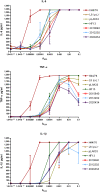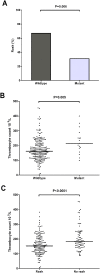Naturally occurring lipid A mutants in neisseria meningitidis from patients with invasive meningococcal disease are associated with reduced coagulopathy
- PMID: 19390612
- PMCID: PMC2667671
- DOI: 10.1371/journal.ppat.1000396
Naturally occurring lipid A mutants in neisseria meningitidis from patients with invasive meningococcal disease are associated with reduced coagulopathy
Abstract
Neisseria meningitidis is a major cause of bacterial meningitis and sepsis worldwide. Lipopolysaccharide (LPS), a major component of the Gram-negative bacterial outer membrane, is sensed by mammalian cells through Toll-like receptor 4 (TLR4), resulting in activation of proinflammatory cytokine pathways. TLR4 recognizes the lipid A moiety of the LPS molecule, and the chemical composition of the lipid A determines how well it is recognized by TLR4. N. meningitidis has been reported to produce lipid A with six acyl chains, the optimal number for TLR4 recognition. Indeed, meningococcal sepsis is generally seen as the prototypical endotoxin-mediated disease. In the present study, we screened meningococcal disease isolates from 464 patients for their ability to induce cytokine production in vitro. We found that around 9% of them were dramatically less potent than wild-type strains. Analysis of the lipid A of several of the low-activity strains by mass spectrometry revealed they were penta-acylated, suggesting a mutation in the lpxL1 or lpxL2 genes required for addition of secondary acyl chains. Sequencing of these genes showed that all the low activity strains had mutations that inactivated the lpxL1 gene. In order to see whether lpxL1 mutants might give a different clinical picture, we investigated the clinical correlate of these mutations in a prospective nationwide observational cohort study of adults with meningococcal meningitis. Patients infected with an lpxL1 mutant presented significantly less frequently with rash and had higher thrombocyte counts, consistent with reduced cytokine induction and less activation of tissue-factor mediated coagulopathy. In conclusion, here we report for the first time that a surprisingly large fraction of meningococcal clinical isolates have LPS with underacylated lipid A due to mutations in the lpxL1 gene. The resulting low-activity LPS may have an important role in virulence by aiding the bacteria to evade the innate immune system. Our results provide the first example of a specific mutation in N. meningitidis that can be correlated with the clinical course of meningococcal disease.
Conflict of interest statement
The authors have declared that no competing interests exist.
Figures






References
-
- Stephens DS, Greenwood B, Brandtzaeg P. Epidemic meningitis, meningococcaemia, and Neisseria meningitidis. Lancet. 2007;369:2196–2210. - PubMed
-
- Beutler B, Rietschel ET. Innate immune sensing and its roots: the story of endotoxin. Nat Rev Immunol. 2003;3:169–176. - PubMed
-
- Parrillo JE. Pathogenetic mechanisms of septic shock. N Engl J Med. 1993;328:1471–1477. - PubMed
-
- Russell JA. Management of sepsis. N Engl J Med. 2006;355:1699–1713. - PubMed
Publication types
MeSH terms
Substances
LinkOut - more resources
Full Text Sources
Other Literature Sources
Medical

